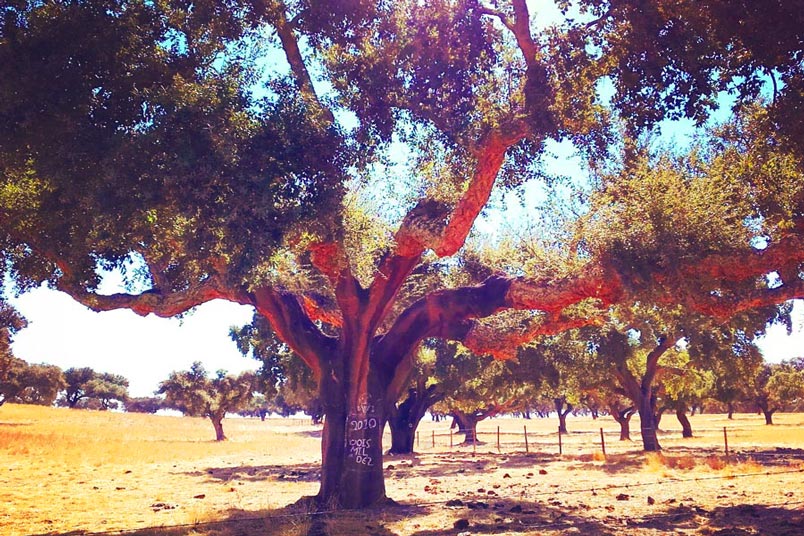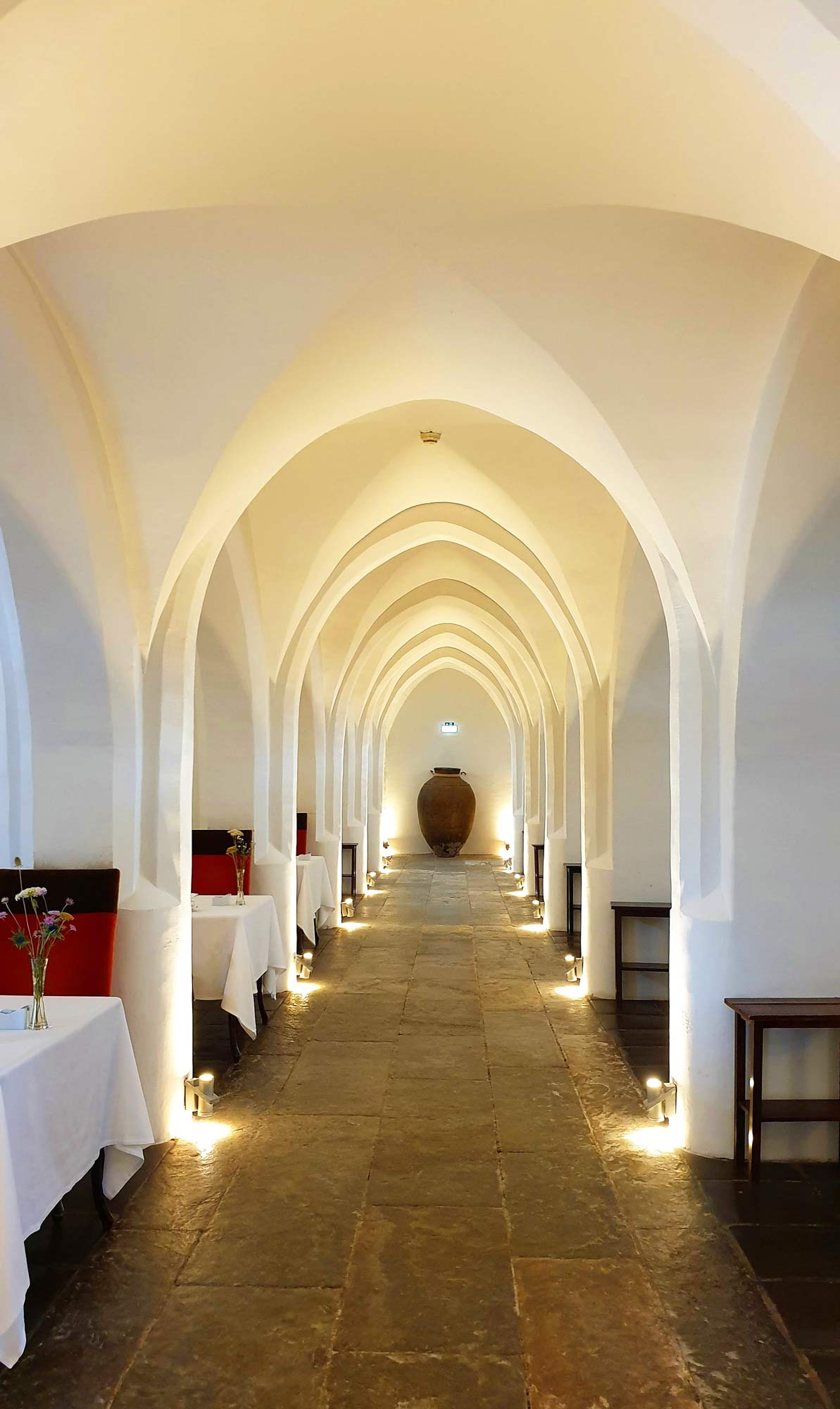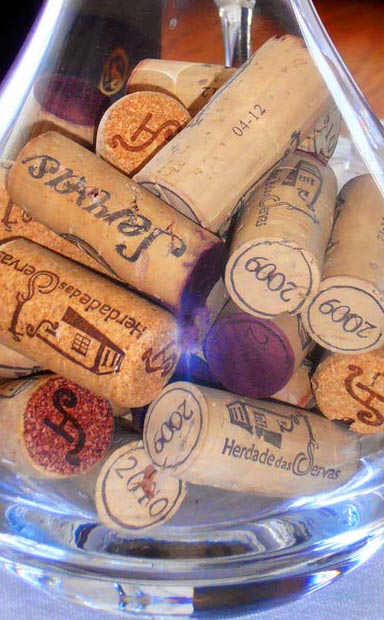
Cork, Portugal’s Sustainable Crop is also one of Iberia`s most enjoyable products. Pop a Cork today and help Portugal’s Cork farmers!
Read time: 10 min

Cork, a Variety of Uses
We all have our great loves. For some, there is nothing better than the sound of uncorking a bottle of delicious wine. Talk to a Cricket fan, they will extoll that lovely sound of leather on willow when the ball connects with the bat.
What do these two have in common? The noble cork tree.
More than 13 billion wine stoppers are produced every year by the cork industry, including stoppers & Champagne corks. (Cork Quality Council)
The World’s Supplier of Cork
It may surprise you to learn that Portugal supplies the world with over 60% of its cork, with Spain coming in 2nd with half of that. There are that many cork trees! In Portugal’s forest almost 30% of trees are cork. As well, certain outside historical factors (past civil war in Spain and instability in Northern Africa) has let Portugal become the dominant market player in this spongy tree product. So sacred is the cork oak, that in Portugal, laws have been created to protect cork trees since the 1200s. It is against the law to cut one down, dead or alive, without expressed permission from the government. It goes to show, how well regarded this plant and its industry is.
What is cork and where does it come from?
Used for thousands of years from Egypt to Greece, the particular type of oak tree of which corks come from, is the bark from a type of oak called the Quercus suber. Growing and excelling in sandy poor soil and hugging the southern coast of western Europe and northern Africa, it is a beautiful addition to an already attractive landscape.
Quercus suber, commonly called the cork oak, is a medium-sized, evergreen oak tree in the Quercus sect
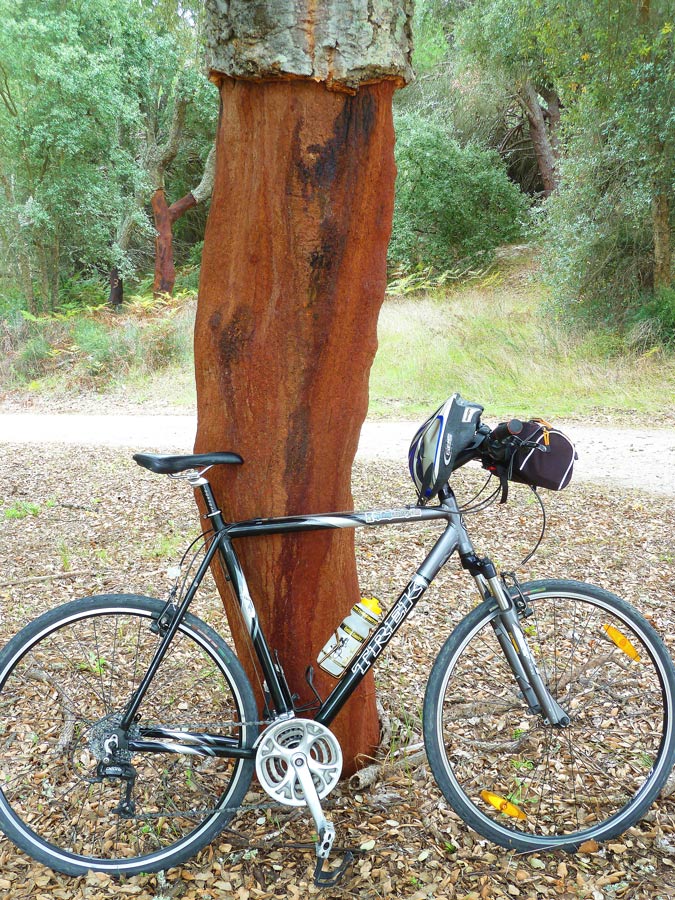
Global cork forests can remove an estimated 14 million tons of carbon dioxide from the atmosphere. (Portuguese Cork Assoc.)
As global warming tragedy looms and we source environmentally friendly transportation, lighting, heating options, we should take particular consideration of this most sustainable and useful tree of the Mediterranean.
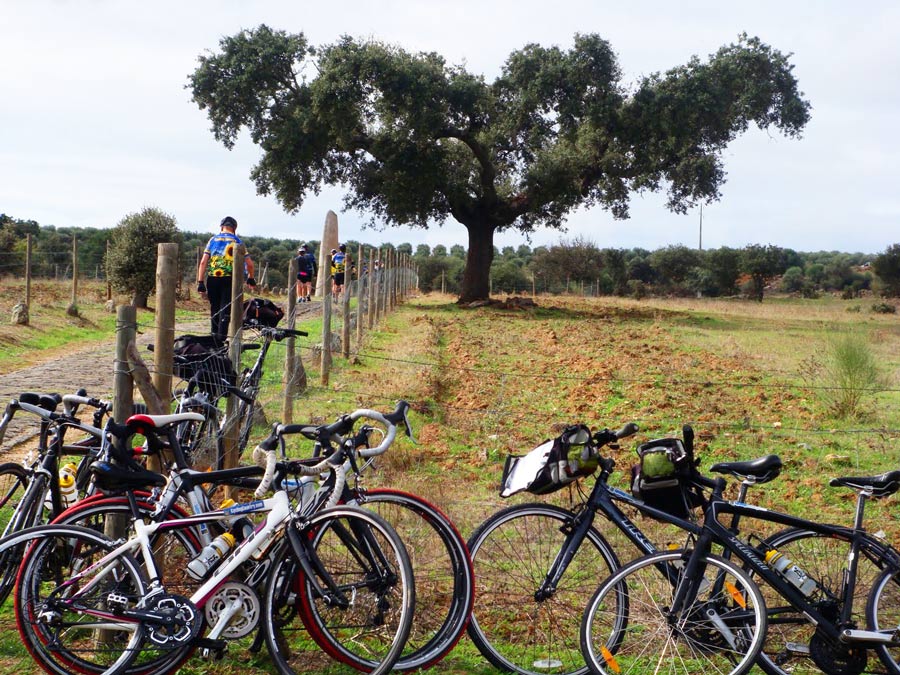
How are Corks Made?
No harm is done to the trees and they are not cut down in order to remove their fantastic buoyant and water resistant springy bark.
First, the trees must mature for at least 25 years before the bark is removed the first time. Once it starts producing, it can be processed every 9 to 12 years and can do so for up to even 200 years!
The process itself is labour intensive however, and the stripping of the trees takes place in the summer every 10 years (by law). Which is why when you are cycling along the roads of Southern Spain and Portugal you will note whitewashed numbers on the trees. This is the date they were last cut, reminding the farmer when to come back and do it again.
Who Harvests Cork?
Removal of the cork is done in the summer due to this being the growing season of the tree and thus it undergoes a vast growth spurt from then on. At this time the bark is carefully split from the tree leaving the base layer a beautiful rust colour. A very delicate manoeuvre, farmers still use fairly rudimentary tools (a sharp axe) as no highly mechanised machine has been developed to strip the bark as well or as carefully. In teams of two (tiradors), one in the tree, the other on the ground, use their hand held axes to carefully peel the tree of its prized possession and lift it in one piece to the ground.
In the agricultural world, cork stripping is one of the highest-paid jobs. It is highly technical and requires a lot of expertise. The average salary begins at €45,000 per year. (Amorim / Payscale)
A completely renewable harvest, you can congratulate yourself every time you uncork a bottle that you are helping this industry that serves to carry on the traditional lifestyle of the cork farmer and the tiradors.
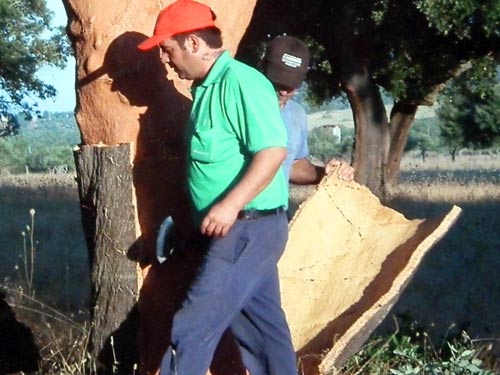


Cork, Portugal’s Sustainable Crop gives the World, Wine Stoppers
Generally, 1 tree can garner up to about 45 kilos of cork, which is enough for 4000 corks… a lot of bottles of wine!
The Biggest Cork Tree in the World is found in Coimbra, near Portugal’s southern area of the Alentejo and has been harvest since the 1820s and stands 14 m tall. It is huge and named The Whistler due to the many birds which nest in its plentiful branches and was named European Tree of the Year in 2018. Its normal harvest has enough for over 100,000 corks!
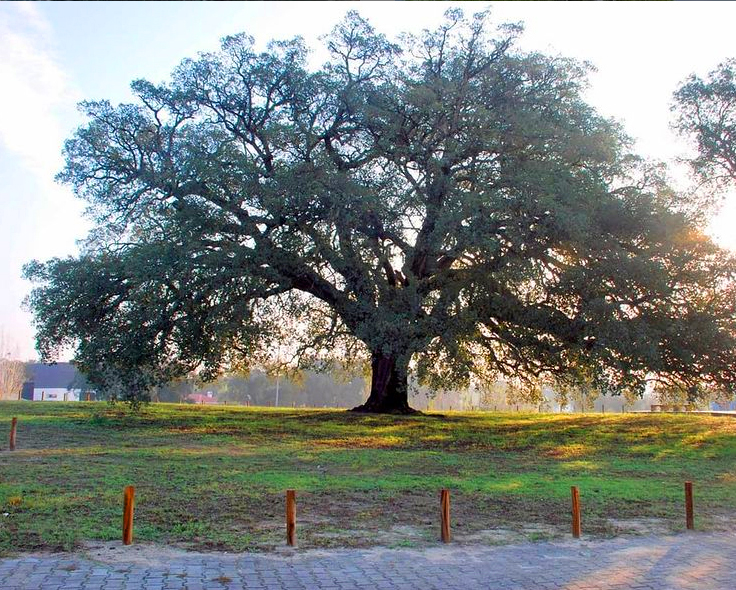
The Whistler Cork “One can only marvel that hundreds of thousands of bottles of wine have been preserved by the bark of this one tree. The cork harvested from the Whistler Cork Oak has been used to close bottles of wine that have been giving joy to people throughout the world for almost two and a half centuries.” João Rui Ferreira of the Portuguese Cork Assoc.
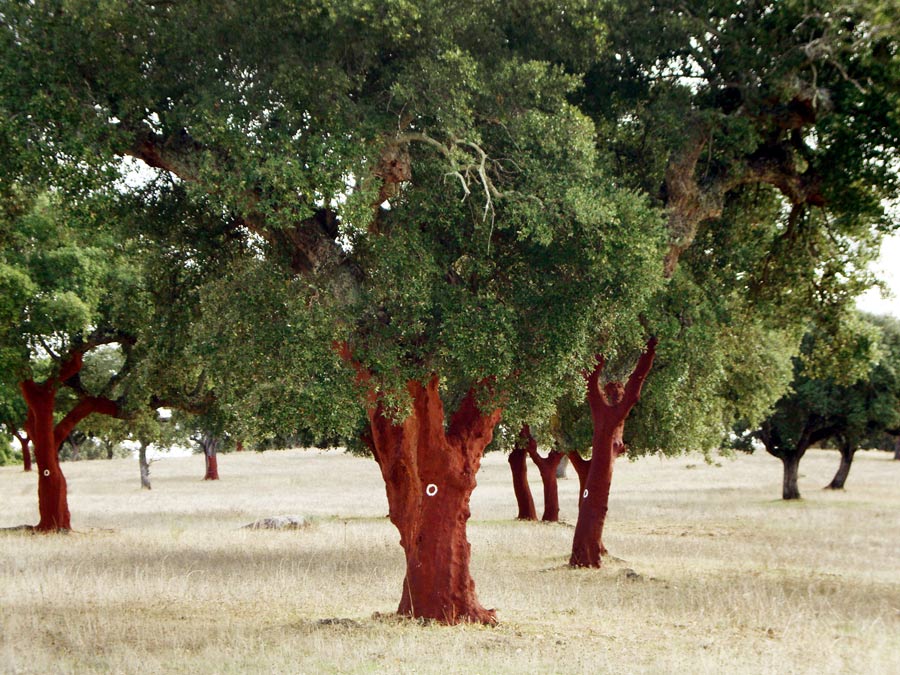
“In typical cork forest(s)…managed, up to 135 different species of plants can be found per sq. meter. (Portuguese Cork Assoc.).

How Does Cork Grow?
Interestingly enough there are different years of growth that are better for some products than others. For example, the loose cellular structure in a young tree stripped of its bark is better used for things like flooring or bulletin boards. As the cork grows, and its structure tightens, from the 3rd harvest and onward, it is best to be used for wine corks (needing a very dense quality). From then on, the cork, Portugal’s sustainable crop, can be used the next 150 years for this product.
How To Process Cork Bark
To process the cork, you will often see farmers transporting these long curved pieces of bark down the highway in big trucks loaded high.
When they reach the processing plants, they are off loaded and put beneath presses for about 6 months. At that point the bark is boiled, further compressed and graded for their uses. Corks, require being the highest grade which is punched out of the flattened bark.
One local Portuguese wine producer even said, that quite often the price of the cork is more than the bottle!
What is Cork Used For?
Traditionally in the Alentejo region over the Tagus river next to the capital Lisbon, people kept food items prior to refrigeration, insulated from the hot sun with decorated cork containers for food. Today it is also used to make everything from wine corks, yoga mats, soundproofing in music studios, hot plates, mouse pads, purses and even shoes and clothes with it. Terrific options for vegans.
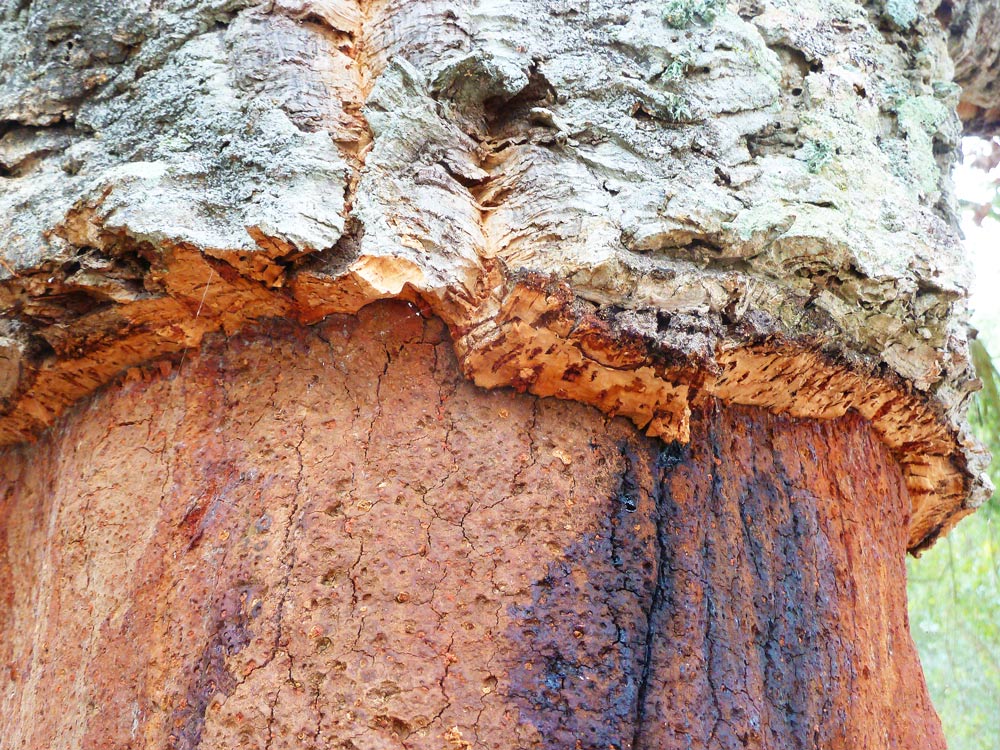
Cork, Portugal’s Sustainable Crop is its most Useful too
In fact, you would be astounded at where the cork has been used.
Apparently, the world’s most expensive whiskey, the 64 year old whiskey, of which there are only 3 bottles, The Dalmore Trinitas 64 (costing a mere 113,000€ per bottle) is sealed with one. For us mere mortals, Coca-Cola used cork when first bottled in the 1890s. Nasa has also used it to absorb heat in its various space designs and cork flooring is used in Spain’s magnificent Sagrada Familia Cathedral and Japan’s illustrious Nezu Museum.

Why Do Wines use Cork?
Harvested since Roman times, it is now under threat by introduced tree species like the Eucalyptus and the plastic cork contingent.
Interestingly enough it was the famed 17th century French monk Dom Perignon who revived the use of the cork seal for bottles due to its complete lack of smell and taste (prior to this they were using oily rags). During this period and into the 20th century, glass bottles were blown by hand, and so the tops could be varying diameters. Cork’s spongy honey-comb cell structure which has an expandable nature, adapts well to fulfilling this need. More so, it was crucial for being able to re-seal the same bottle in order to reuse it’s contents as in medicines, perfumes, etc..

The Controversy about Corks
However, these days, tastes are more discerning and cork producers are being urged to improve their product. The anxiety is an organic chemical component/fungi called trichloroanisole, (TCA) in the cork which can “cork” (ruin/taint) a wine if it comes into contact with any chlorine at all. Wineries face losing the battle in the industry to its plastic cork brother or even .. gasp, the screw cap. Commonly accepted is the 3-5% rate of TCA corking wine, which of course is unacceptable to many and some believe it could even be up at 10%.
It is now believed that about 20% of table wines sold in the world today have moved on from cork to aluminium caps. (The Atlantic)
Will there come a day when corks are no longer used in wine bottles at all?
Well, the cork industry hopes not and that the preservation of the tradition of pulling a cork out of a bottle will sustain them. However, the “new world” exceptional wines of Australia and Chile have moved into newer capping technologies, so it may be only a matter of time. The question of cost, of course remains for wineries too, with screw caps being much cheaper in comparison to their natural cousins.
What are wineries doing to preserve the cork tradition?
Many wineries have gone to great lengths to prevent this compound from developing and the banning of chlorine cleaning products helps in that battle. However, on the other side there are believers that it is the minute traces of oxygen that corks let in which makes the wine and the 100% seal that plastics have can also cause a reaction). As you can imagine this is a very contentious issue and many on the other side have debunked this as a myth.
It is not all doom and gloom though and there are many organizations working hard to preserve Mediterranean cork forests, their biosystem and of course their traditional product.
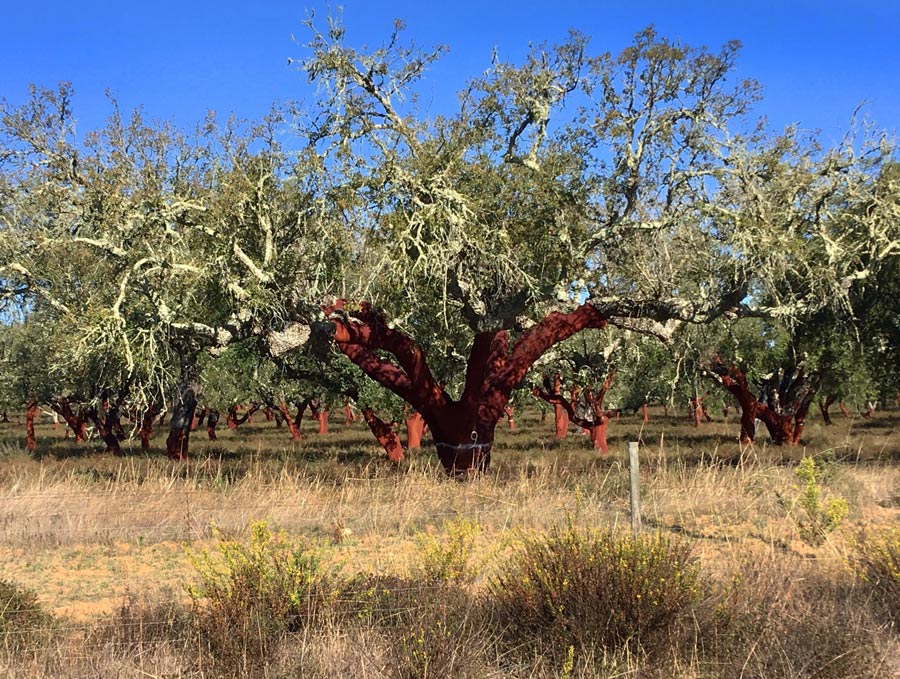
“The best time to plant a tree was 20 years ago.
The second best time, is now.”
Chinese proverb
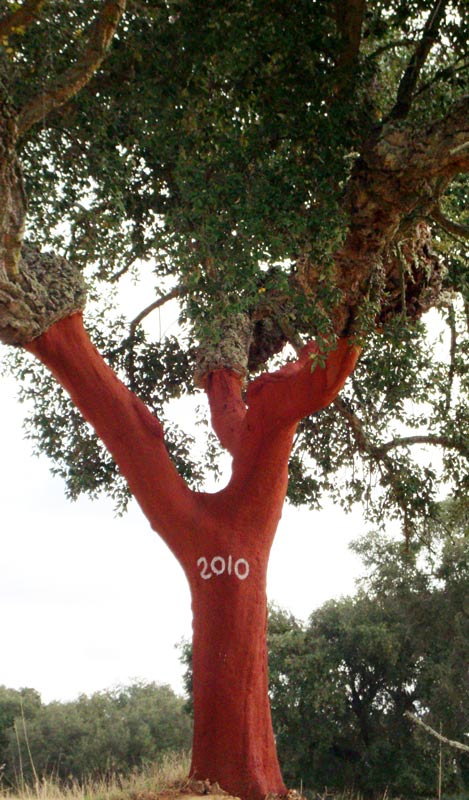
Cork, Portugal’s Sustainable Crop & part of its Heritage
So, it is time to embrace a tree, become a tree hugger, specifically, the cork. Its versatility is immense, its good, incalculable, its history, noble and its striking shape against a setting sun, a part of the beautiful Portuguese landscape.
Thus we should ask ourselves, can we afford to shun such an environmentally, culturally beneficial tree? At the very least, can we really replace that satisfying “thuuck” sound of pulling a cork out of the bottle? Certainly, having a distinguished sommelier bringing to your table an expensive bottle and twisting off the cap certainly loses that something wonderful and exciting the humble cork brings.

Links
Learn more about cork here:
- Join our self guided and guided bike trips in Portugal
- European Tree of the Year
- Cork Re-harvest – Stewardship Cork forests
- ReCork – Reusing Used Corks
- Portuguese Cork Association

